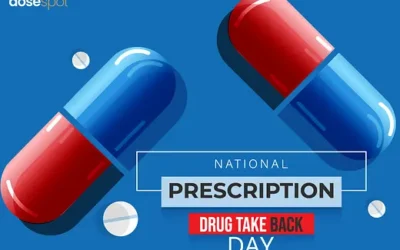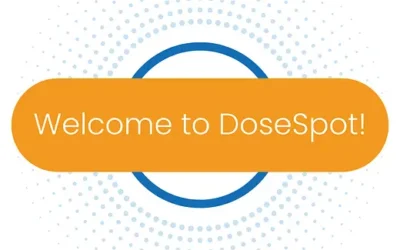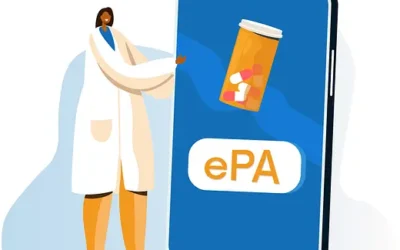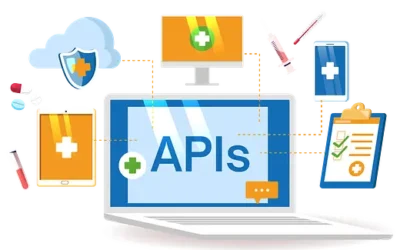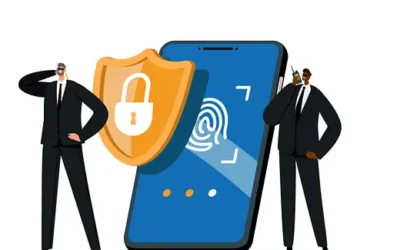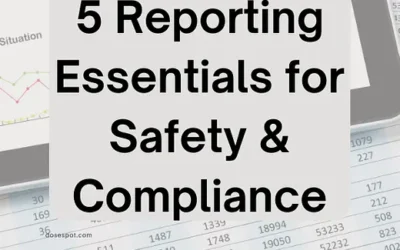DoseSpot Blogs:
ePrescribing Software News, Integrations, and Industry Trends
Welcome to the DoseSpot Blog page! Here, you’ll find the latest updates, expert insights, and industry news on ePrescribing software, integrations, and healthcare technology trends. Stay informed and inspired as we explore the innovations shaping the future of healthcare.
For Solo Providers: Simplifying ePrescribing Without an EHR
BLOGIn the ever-evolving landscape of healthcare, solo providers find themselves at the intersection of increasing patient demands, regulatory complexities, and administrative overload. From managing clinical care to running day-to-day operations, independent...
New Strategic Collaboration with Lightning Step
BLOGAt DoseSpot, we are committed to helping providers manage prescriptions in a smarter, more efficient way that ultimately benefits patients. We’re excited to announce a new strategic collaboration with Lightning Step that will give behavioral health organizations...
A Critical Moment for Telehealth Prescribing: DEA’s Proposed Rule Update
BLOGAs the DEA’s proposed rule on telehealth prescribing of controlled substances moves through the final stages of review, stakeholders across healthcare, telemedicine, and patient advocacy are keeping a close watch. The implications of this rule could significantly...
Understanding EPCS Certification
BLOGElectronic Prescribing of Controlled Substances (EPCS) certification is a crucial development in the healthcare industry, designed to facilitate the secure and legal electronic transmission of prescriptions for controlled substances. This certification process...
Enhancing Patient Safety with EPCS: A High-Level Overview
BLOGEffective January 1st of 2023, the Centers for Medicare and Medicaid Services (CMS) mandated the use of electronic prescribing of controlled substances (EPCS). This mandate means all schedule II, III, IV, and V controlled substance prescriptions under the Medicare...
Adapting to Future Needs in E-Prescribing: How DoseSpot Leads the Way
BLOGIn recent years, healthcare provider technology has seen significant advancements in e-prescribing, which aim to streamline processes, improve patient outcomes, and ensure regulatory compliance. This article examines how DoseSpot is at the forefront of these...
How DoseSpot Simplifies the E-Prescribing Process for Dental Practices
BLOGIn today’s competitive dental industry, efficiency and superior patient care go hand in hand with thriving practices. As technology continues to evolve, dental practices are also continually seeking innovative solutions to streamline their operations and enhance...
What You Need To Know: DEA Proposed Rule Regarding Telehealth Prescribing of Controlled Substances with the White House
BLOGAs of June 2024, a DEA proposed rule regarding telehealth prescribing of controlled substances has reached the White House for review. This review is the final step before the proposal can be released to the public. Background on the Proposed Rule At the start of...
10 Ways to Set Practice Managers Up for Success When Implementing ePrescribing
BLOGJune 6, 2024 Practice managers play an essential role in the day-to-day operations of a medical practice, ensuring that it runs smoothly and efficiently. They are often referred to as the glue that holds the practice together because of their expansive...
The Interoperability and Prior Authorization Final Rule: Implications for Providers, Patients, and Care Delivery
BLOGIn an era of rapid technological advancement in healthcare, regulatory changes are driving a new dawn of efficiency and patient-centered care. The Interoperability and Prior Authorization Final Rule (CMS-0057-F) by the Centers for Medicare & Medicaid Services...
Say Goodbye to Sticker Shock: Leveraging Real-Time Prescription Benefit in Your EHR
BLOGApril 18, 2024 Real-Time Prescription Benefit (RTPB) is changing the game when it comes to handling prescriptions. It offers unparalleled drug-price transparency right when it’s needed most, and it fits into the ePrescribing tools doctors already use. DoseSpot...
Safe Disposal, Safer Communities: The Impact of Taking Back Meds
BLOGApril 9, 2024 In a world where prescription medications are a part of many people’s daily lives, it’s crucial to know how to use them safely and responsibly when they’re no longer needed. National Prescription Drug Take Back Day is a great opportunity to clean out...
The Power of ePA Integration: Streamlining Prior Authorizations for a Better Healthcare Experience
BLOGMarch 26, 2024 For healthcare providers across various specialties, including dental, behavioral health, digital health, telehealth, and direct primary care, obtaining Prior Authorizations (PAs) remains a significant pain point. The traditional method, rife with...
Securing Healthcare by Strengthening Identity Verification
BLOGMarch 25, 2024 Over the past decade, the delivery of healthcare services has undergone a digital revolution, including ePrescribing and identity proofing—a process implemented to validate an individual’s identity in a remote transaction. As telehealth gains...
Beyond the Fax: A Closer Look at the Evolution of ePrescribing
BLOGFebruary 26, 2024 The ePrescription Origin Story Let’s journey back to the not-so-distant days of analog prescribing methods… A patient visits a physician and, upon evaluation, obtains a handwritten prescription that is either faxed to their pharmacy of choice or...
How ePrescribing Wins the Hearts of Healthcare Technology
BLOGA Love Letter to Innovation February 13, 2024 Roses are red, violets are blue, DoseSpot’s personalized ePrescribing software is a match made in healthcare innovation for you. When it comes to innovating and optimizing your healthcare clinical operations through...
Security Savvy in Healthcare Tech: Ensuring the Protection of SOC 2 and HITRUST
BLOGJanuary 30, 2024 When it comes to healthcare technology and protecting Personal Healthcare Information (PHI), data security isn’t just a box to tick – it’s a sacred trust. We’re dealing with lifeblood information, the most intimate details woven into the fabric of...
Behind the Code with Our CTO: Building Real-Time Prescription Benefit
BLOGJanuary 23, 2024 This interview was previously published on our DoseSpot Built In Careers Page. Find the full post here. Ever wondered how the magic happens behind the scenes at DoseSpot? Today, we’re giving you an exclusive peek into a conversation with our Chief...
The Process of ePrescribing: A Quick-start Guide from DoseSpot
BLOGDecember 7, 2023 Technology is continuing to advance, delivering new ways to help providers improve patient care. One of the most important and widely used tech tools for modernized clinical practice is electronic prescribing, as supported by the Academy of...
5 New Upgrades to the Client Support Community
BLOGNovember 9, 2023 After months of collecting user feedback there is now an easier way to get the help and support you need with DoseSpot through our new and improved DoseSpot Client Community. Our client community has been reorganized with a fresh, clean design...
Red Flags: Identifying a Job Scam
BLOGNovember 9, 2023 We encourage you to continue exploring opportunities at DoseSpot but urge you to be cautious and mindful of potential job scammers pretending to be part of the DoseSpot People Operations Team. We will only email you from @dosespot.com. According...
How to Be the Hero When Making the ePrescribing Software Switch
BLOGNovember 8, 2023 ePrescribing is a good way to improve the efficiency and accuracy of prescribing medications. It allows physicians to send prescriptions directly to pharmacies electronically, eliminating the need for handwritten prescriptions. And in many...
3 Key Messages from Attending MGMA23 in Nashville
BLOGOctober 30, 2023 The 2023 MGMA Leaders Conference in Nashville, TN, was a major event for the healthcare industry, bringing together leaders from all over the country to discuss the most pressing issues facing the profession today. Three themes our team picked up...
ePrescribing in Hospice Care: A Safer Way to Provide Patient Care
BLOGOctober 5, 2023 Hospice care made its way into the U.S. in the early 1970s as a new way to provide comfort and support to people nearing the end of their lives. It is not focused on cures but on relieving pain and other symptoms of chronic illness, old age, and...
How Much Does an ePrescribing Platform Cost?
BLOGSeptember 20, 2023 As with any software as a service solution (SaaS), understanding the costs associated with implementing an ePrescribing platform is crucial for healthcare providers and organizations. As you read further, we’ll delve into the various factors...
Establishing Best Practices and Frameworks for Ethical Prescribing
BLOGSeptember 5, 2023 The central focus of every healthcare practice should be the welfare of patients. Being patient-centered means effectively upholding the regulatory requirements that align the practice with industry standards. This includes appropriate...
No EHR Required: How Startup Digital Healthcare Companies and Single Providers Can Start ePrescribing Now
BLOGAugust 25, 2023 Entrepreneurs everywhere are trying to solve a piece of the healthcare puzzle. According to Crunchbase, in 2022 alone, approximately 572 health tech startups received funding in the U.S. to continue developing their ideas through innovative...
Why the Delays at Pharmacies? How Electronic Prior Authorization and Real-Time Prescription Benefit Can Help
BLOGPharmacies are crucial in ensuring patients have timely access to their medications. However, prescription pickup delays have become a common concern for both patients and healthcare providers. These delays can cause more than an inconvenience. They disrupt...
4 Steps to Get Your EHR Software Integrations Clinician-Ready
BLOGJuly 3, 2023 Electronic Health Record Software Integrations When it comes to Electronic Health Record (EHR) and Electronic Medical Record (EMR) integrations, they should be provider friendly. During a patient appointment, clinicians don’t have time to open...
Controlled Substances: Using a PDMP at the Point of Care
BLOGJune 2023 Decades ago, many opioid addictions began with hard narcotics, such as heroin, that were obtained illegally, but as we move deeper into the twentieth century, many opioid addictions begin with a well-intentioned prescription for pain. The truth is, if...
DEA Temporarily Extends Telemedicine Flexibilities for the Prescribing of Controlled Substances
BLOGUpdated October 11, 2023 On October 6, 2023, the DEA extended Telemedicine Flexibilities for Prescribing Controlled Substances for a second time. Nearly one month after two full days of DEA organized listening sessions on September 12th and 13th, another temporary...
PSG-Backed DoseSpot and pVerify Join Forces to Expand API-driven Capabilities and Help Improve Patient Access to Healthcare
BLOGJune 2023 DoseSpot announced today it has acquired pVerify, a solution that streamlines the front-end patient eligibility verification process, helps patients get necessary care and aims to reduce overall healthcare costs. “Joining forces with pVerify is an...
Introducing the Voice of DoseSpot: Naomi Martinez
BLOGMay 2023 We are excited to announce that we have a new “voice” at DoseSpot! Naomi Martinez makes many contributions as an employee. Welcoming you to DoseSpot through our phone system upgrade is only one of them! Soon, you will hear Naomi presenting you with...
Proof that Electronic Prior Authorization is Exactly What You’ve Been Looking For
BLOGMay 2023 Prior authorization (or pre-authorization) is a process by which healthcare providers confirm that a drug, service, healthcare action, or piece of equipment is medically necessary for a patient. Confirmation of medical necessity helps determine the amount...
How Telemedicine and ePrescribing Have Impacted the Treatment of Those with Opioid Use Disorder (OUD)
BLOGTelehealth has significantly impacted how individuals with opioid use disorder (OUD) obtain medical treatment. In many cases, digital healthcare has made it easier for individuals with OUD to access timely medical care and treatment. The Drug Enforcement...
Build or Buy: How to Decide Your ePrescribing Product Strategy
BLOGMay 2023 Healthcare companies will continue to digitize, and ePrescribing is essential to ensuring prescriptions are reliable, safe, and manageable. Without having to recreate the wheel, EMR, and medical software companies can add ePrescribing functionality at the...
The Difference Between Virtual Care, Telemedicine, and Digital Healthcare
BLOGThe care continuum is changing to catch up to the demands and needs of patients, but what does it all mean? Is your practice set up to deliver care virtually? Do you schedule telehealth appointments with your patients? Are digital health tools part of how you...
Press Release: DoseSpot Acquires TreatRx from Bravado Health
BLOGDoseSpot has recently acquired TreatRx, Bravado Health’s ePrescribing business, enabling us to expand our capabilities and serve more customers. Their platform, Treat 5 is a standalone solution with no EHR/EMR required. By welcoming Treat, we can create even more...
Get More From Your Medical & Dental Software by Customizing With APIs
BLOGIn the race for a digital healthcare world, the number of Electronic Medical Records and Electronic Health Records software companies has grown exponentially. Added to this growth is the myriad of Federal and State government healthcare software regulations,...
2023 Regulatory Changes: 6 ePrescribing Rules That Providers Should be Monitoring
BLOGUpdated, May 2023 2023 is shaping up to be an active year for prescribers. The Biden administration’s first term is in full swing and is facing a divided Congress, affording a very narrow opportunity for major legislative wins. Further, most major regulations will...
How to Curb Doctor Shopping, Reduce Opioid Abuse, and Save Lives
BLOGThe opioid crisis is getting worse.ePrescriptions can help. Prescription drug abuse has reached alarming levels, and people are dying at unprecedented rates. Almost 50,000 people die every year from opioid overdose alone. According to the National Center for Drug...
Identity Proofing (IDP): Why It’s Essential to Patient and Prescriber Safety
BLOGPeople steal digital identities at an alarming rate, with Medical Identity Theft being a key target. Medical Identity Theft is when someone steals or uses your personal information (like your name, Social Security number, or Medicare number) to submit fraudulent...
4 Interesting Facts About Real-Time Prescription Benefit
BLOGThis article was originally written by DoseSpot for Open Dental Blog. That article can be viewed here. February 2023 In today’s world, as consumers, we can personalize nearly everything. On our way to work, with the swipe of a few buttons, we can customize a cup...
ePrescribing Reporting: 5 Essentials for Safety and Compliance
BLOGAre you searching for ways to lift your customer satisfaction scores? How about improving employee retention? One way to do it is to move more of your practice applications to the cloud. According to the American Dental Association, close to 34% of dentists...
3 Reasons You Should Move Your Dental ePrescribing Software to Cloud-Based Technology
BLOGAre you searching for ways to lift your customer satisfaction scores? How about improving employee retention? One way to do it is to move more of your practice applications to the cloud. According to the American Dental Association, close to 34% of dentists...
What is the difference between an Electronic Health Record (EHR) and Electronic Medical Record (EMR)?
BLOGUnderstanding the difference Electronic health records and electronic medical records tend to be used interchangeably, with many assuming that the two are the same. Although both EMRs and EHRs involve the digital record-keeping of essential medical information,...











